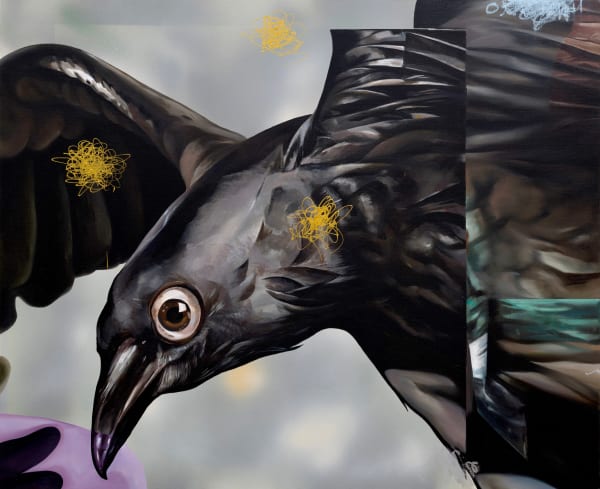Geng Yini: The Dwarf Planet That Has Been Demoted
Curator / Leo Li Chen
Pluto was once considered the ninth planet in our solar system, but in 2006, the International Astronomical Union (IAU) redefined the criteria for a “planet,” resulting in Pluto being downgraded to a “dwarf planet.”Geng Yini has titled one of her new works “Dwarf planet that has been demoted” (2024), and the “dwarf planet” here is a reference to Shenyang in Northeast China, where she grew up and lives. Rather than discussing the grand social issues of Northeast China in the context of the times, it conveys a more simple fact of existence: the complexity of the subject under the seemingly passive “out”, and the self-identification after the accelerated and lagging memory.
Geng Yini's painting practice has always been rooted in the social reality of Northeast China, with history and memory, collectivity and individuality intertwined to form the realistic undertones of her paintings. At the same time, most of the images in her paintings come from photographs, internet pictures and botanical illustrated books that she has taken or collected. This also makes Geng Yini's paintings present a fictional quality based on reality, and she is always dealing with how to transform the fragments of her personal memories and perceptions into her paintings, thus penetrating the rupture between history and reality and the vulnerability of the individual under the tide of the times.
This solo exhibition presents new works created by Geng Yini between 2021 and 2024. The blood-swollen “Hercules” that often appeared in her previous works are off-stage, and the western food chef with knife and fork comes on stage; the ferocious animals and hunting games become the stagnant and awkward ducks and geese, the crows that can't distinguish between good and evil, the swallows in her childhood memories, and the worker bees that are tired of running for their lives. Absurdity is no longer revealed as direct confrontation, but is transformed into an inexorable retreat into the mud, and the resilience of self-repair and healing. As a result, Geng Yini's new works have gradually developed a new outlook on the regional nature of their subject matter, which appears to be a private but precisely a more universal individual predicament.
Geng Yini's new works attempt to address a more universal reality, how the individual negotiates with external pressures: not in direct confrontation, but not in total abandonment; decadent, but not lyrical; how to regain elasticity in the midst of compression, and how to seek a place of support in the midst of loss. In the images of these works, the background and the subject are references to each other, and the simultaneous appearance of multiple subjects in the images also breaks down the so-called stable mechanism of power; the artist handles the images with thin but not glattened strokes to make the structural relationships more homogeneous; the bodies, animals, and plants depicted are handled with extreme restraint in terms of mechanism, light, and shadow, which enables the viewer to finda silence in what seems to be a playfully and discorderly rhythm.
In Geng Yini's painting practice, she always emphasizes the traces of image processing. For example, the blurred or artificial edges, the collage-like combination of images, she intentionally retains the imprint of editing the image material in the picture. This is both an exploration of pictoriality, and at the same time how she appeals to memory and perception in the painting process. The crows, the swallows, the eyes, the floor tiles ... they are both leftover historical memories and existing social realities. There are also those unconscious lines and strokes that always intrude somewhere in the picture. Of course, we can attribute it to the free exposure of the artist's individual emotion, which appears to be sudden but appropriate. If we are all experiencing a general loss under the tide of the times, then these traces are the anchors of individuals in the tarry voyage.
-
 Geng Yini 耿旖旎, Alpine Strawberry 高山草莓, 2024
Geng Yini 耿旖旎, Alpine Strawberry 高山草莓, 2024 -
 Geng Yini 耿旖旎, Big Boss of Pie Frisbee 馅饼飞盘大老板, 2023
Geng Yini 耿旖旎, Big Boss of Pie Frisbee 馅饼飞盘大老板, 2023 -
 Geng Yini 耿旖旎, Under The Floors Is Grimshaw by Night 地板下是格里姆肖的夜色, 2023
Geng Yini 耿旖旎, Under The Floors Is Grimshaw by Night 地板下是格里姆肖的夜色, 2023 -
 Geng Yini 耿旖旎, Honey Locust Tree (Acacia) 蜂蜜蝗树(刺槐), 2022
Geng Yini 耿旖旎, Honey Locust Tree (Acacia) 蜂蜜蝗树(刺槐), 2022
-
 Geng Yini 耿旖旎, Thorny Tail 带刺的尾巴, 2023
Geng Yini 耿旖旎, Thorny Tail 带刺的尾巴, 2023 -
 Geng Yini 耿旖旎, Blizzard 暴雪 , 2022
Geng Yini 耿旖旎, Blizzard 暴雪 , 2022 -
 Geng Yini 耿旖旎, Sounds of Home 乡音, 2022
Geng Yini 耿旖旎, Sounds of Home 乡音, 2022 -
 Geng Yini 耿旖旎, The Dwarf Planet That Has Been Demoted 被出局的矮行星, 2024
Geng Yini 耿旖旎, The Dwarf Planet That Has Been Demoted 被出局的矮行星, 2024


















